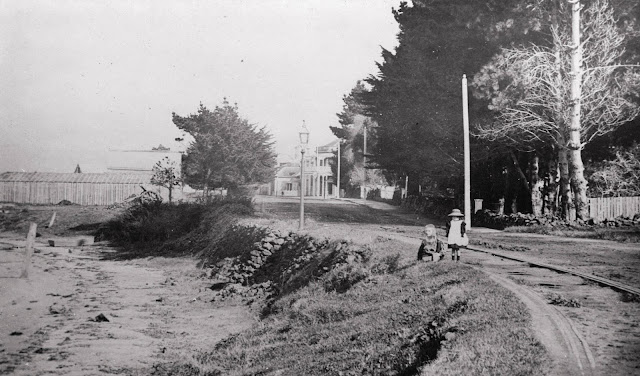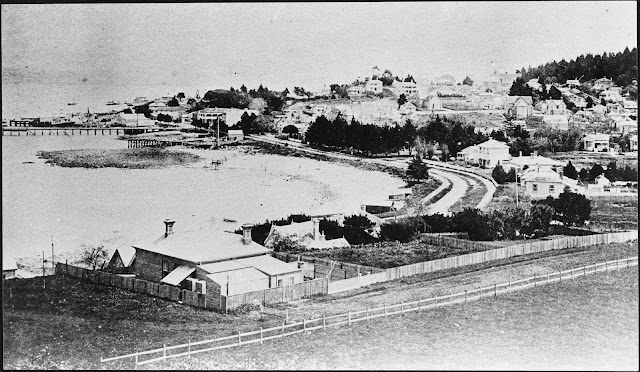A ride on the Devonport horse Tramway
 |
| James D Richardson, "A woman and a girl beside the Devonport and Lake Takapuna Tramway tracks at Duders Beach, ca 1890". Auckland Libraries Heritage collections 4-3032. |
Spring 1886 heralded a long-awaited event for the people of Devonport. For three years, the community had discussed the merits of a horse tramway, but a false start, funding problems, and disputes with the local government delayed the opening of the first section of the Devonport and Lake Takapuna Tramway until Saturday, 25 September.
 |
| Contract Plan of Devonport Tramway First Section, 23 November 1885. Courtesy Archives New Zealand R1947629. |
The inaugural run across the first section, between Victoria Wharf and Cheltenham Beach, was a publicity stunt intended to drum up sales of shares as much as to open the line. Reports of the event provide some of our only clues into the operation and quality of the tramway. Journalists noted that the “line is level for nearly the whole distance…and judging from the smoothness and ease with which the tramcars traversed the distance the road has been thoroughly well laid down.” The Herald reporter also described the cars in positive terms:
The cars are light and airy vehicles, each being capable of carrying fifty passengers. They were built by Messrs. Cousins and Atkin, from designs by the engineers. The wheels were made at Mr. Masefield's establishment, and the whole of the work of the trams was done in Auckland. The cost is about one-third that of imported cars, and though not so elaborate in construction, they are fully strong enough, and excellently adapted for their present purpose.
Due to tramcar capacity, the celebration hosted no more than 100 guests, mostly shareholders, their families, reporters, and leading figures on the North Shore. Many of the dignitaries travelled to Devonport via steam ferry, which arrived at Victoria Wharf around 1:00 pm. From there, the party immediately boarded the waiting cars and began the 1.6 km journey to Cheltenham Beach.
 |
| Burton Brothers, "The PS Britannia berthed at the end of Victoria Wharf in Devonport, 1888". Auckland Libraries Heritage Collections D_GW_0026. |
While no photographs exist of the tramway when it operated, many photographs of Devonport survive from the period. These provide an idea of what a ride on the tramway would have felt like in the spring and summer of 1886.
 |
| Unknown, "View down Victoria Road looking toward the wharf, 1890". Auckland Libraries Heritage Collections T0544. |
Trams began their journey from the foot of Victoria Wharf. They were scheduled synchronously with the Devonport Steam Ferry Company’s timetable, although neither company was known for its punctuality. A planned combination ticket office and waiting room at the foot of the wharf was never built, so tickets were sold directly on tramcars by the conductors. An “excellent” horse led each car, which moved no faster than 10 miles per hour (16 kph).
 |
| Unknown, "View down King Edward Parade across Windsor Reserve toward Mays Street, 1890s". Auckland Libraries Heritage Collections D-GPW-0011. |
From the wharf, the tramway briefly ran down the centre of Victoria Road before turning onto Beach Road (now King Edward Parade). A primary appeal of the tramway was to bring tourists and prospective property buyers to the beaches of North Shore. To do so, the company built a stone retaining wall 5-8 feet high along Devonport and Duders Beaches to support the weight of the tramcars and ensure the integrity of the right-of-way. It also allowed for an unimpeded view of Waitematā Harbour, which must have been impressive to those unfamiliar with the area.
 |
| James D. Richardson, "R. & R. Duder’s Devonport Store & Bakery at Church Street with the Duder Brothers standing out front, ca 1890". Auckland Libraries Heritage Collections 4-7245. |
The tramway had two regular stops along the line, the first being Church Street. This location marked the start of the North Road to Lake Pupuke and Waiwera Hot Springs. It also hosted Devonport Wharf. In the mid-1880s, the wharf and businesses along Church Street were still competitive with those on Victoria Road and it was likely a popular stop for commuters and residents.
 |
| Newspaper timetable for the Devonport and Lake Takapuna Tramway dated 19 November 1886.New Zealand Herald, Volume XXIII, Issue 7799, 19 November 1886, Page 3. |
The only difficult curve on the line was at Alison’s Corner, where tramcars turned up Cheltenham Road. During construction, the tramway company had to recall its engineers to install a wider curve, a task that resulted in a lawsuit when the company failed to pay for the extra work. This section was also the worst maintained since the track ran down the middle of the road and travellers rode their omnibuses, wagons, and horses over it without concern.
 |
| James D. Richardson, "A cricket game held on the grounds at Devonport Domain, 1903". Auckland Libraries Heritage Collections 4-3088. |
The second stop along the line was probably Jubilee Avenue, where property developers hoped to sell land. Visitors could also detrain here to visit Devonport Domain. In 1886, the Domain was a grassy field where cricket, rugby, and football games were played. The bowling green and tennis lawn were not added until the late 1880s. Jubilee also marked the highest elevation along the tramway at 12 metres above sea level, which journalists on the initial run reported as “being a short bit, which is at a very easy gradient.”
 |
| James D. Richardson, "View of the Devonport Domain with the Devonport tramway’s carbarn and stable at centre-left behind the two homes, ca 1890". Auckland Libraries Heritage Collections 4-2968. |
Down Cheltenham Road another block, a spur was installed up Lake Street (Tainui Road) to William Street (Eton Avenue). It was here that the company built its stable and carbarn, “a commodious and convenient structure, excellently adapted for the comfort of the horses and convenience of the traffic.” The stable was a tall barn that dominated the surrounding buildings, while the carbarn was a canvas-wrapped, barrel-vaulted structure that sat in the field beside the stable.
 |
| Unknown, "The Cobley family’s residence at Cheltenham Beach, 1873". Auckland Libraries Heritage Collections D_GVDE_0033. |
Still further down the road, the tramway reached its Cheltenham Beach terminus. Here and at Victoria Wharf, the tramcar’s horse would be detached from one end of the car and reattached to the other to reverse the journey. Where McHugh’s restaurant sits on the beach today, in 1886 the area was barren. Nonetheless, Cheltenham had been a primary attraction since the 1860s, when William Cobley laid out magnificent gardens on an adjacent 40-acre lot. He named them after Cheltenham Gardens in England, and developers jumped at the opportunity to sell nearby properties for baches and weekend homes.
 |
| Unknown, "Bathers relaxing on Cheltenham Beach near the end of the Devonport tramway, ca 1890s". Auckland Libraries Heritage Collections 755-Album-17-68. |
During a picnic at the beach after the inaugural ride, company chairman Graves Aickin promised that the party “had on that occasion seen but a portion of the line, which was to be extended considerably as funds would permit.” Indeed, plans from the beginning promoted branches to Lake Pupuke, Narrow Neck, and Stanley Bay. He guaranteed that the “portion already constructed would certainly pay, and when extended it would pay better.” And then he asked that “all interested in the district would come forward and take a few shares.”
 |
| Unknown, Portrait of Graves Aickin, 1880s. Auckland Libraries Heritage Collections 5-2739-05. |
Aickin was not naïve. He understood that the tramway would not be an immediate success and argued that, “although the times were very dull, there was good reason to hope for the future success of their undertaking, for as the North Shore was one of the most beautiful localities around the city, there was sure to be an increase of population there, if anywhere.” He was correct, but about two decades ahead of his time.
 |
| Two children climbing on an abandoned Devonport tramcar on the carbarn lot off Eton Avenue, 1904. Courtesy Devonport Museum. |
In the end, the Devonport and Lake Takapuna Tramway failed to convince investors or the public. By February 1887, lawsuits and debt forced the company to dissolve. The franchise was taken over by R. & R. Duder, local merchants, but they quickly gave up on the tramway. The tracks languished until December 1894, when they were taken up. Despite several efforts to resurrect the project, Devonport never again built a tramway.

Comments
Post a Comment
Kia ora! Please leave your comment below.